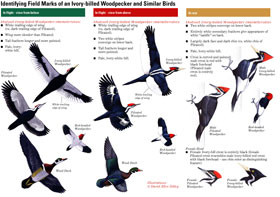  |
| HOME | THIS ISSUE | CALENDAR | GRANTS | BACK ISSUES | < BACK | NEXT > |
UConn biologist disputes identification of rare woodpeckerby Cindy Weiss - March 20, 2006 |
||||
|
A paper co-authored by a UConn biologist and published this week in the journal Science challenges the bird identification that led to one of the most dramatic science stories of the decade: the reported rediscovery last spring of the ivory-billed woodpecker, which was thought to be extinct in the United States. In a peer-reviewed technical comment published in Science, bird identification expert David Sibley and three co-authors, including Chris Elphick, an assistant professor of ecology and evolutionary biology at UConn, argue that the identification of the ivory-bill is in doubt. A video of the bird taken in the Big Woods of Arkansas most likely shows a fairly common pileated woodpecker, they write. Last spring’s identification of the ivory-bill was widely reported in the press and led to announcements of more than $10 million in funding from federal and private agencies to preserve the rare bird and its remaining habitat. This week’s Science includes a response by scientists at the Cornell Laboratory of Ornithology, disputing the paper by Sibley, Elphick, and their co-authors. Cornell scientists were the lead authors of the original ivory-bill identification in Science last June. In their technical response, they maintain their claim that the bird shown in their video is an ivory-bill. The video was taken by an engineering professor from the University of Arkansas, a co-author on the original paper, as his canoe came within 20 meters of a large water tupelo tree in the swampy Big Woods. It shows four seconds of blurry flight as the bird took off, flying into the woods and away from the boat. The video has been extensively analyzed, frame by frame, by both groups of scientists. Whether the bird was an ivory-billed or a pileated woodpecker could affect conservation efforts in the Big Woods, one of the last remaining large tracts of old-growth, bottomland hardwood forest in the South. It is the type of habitat that was favored by the ivory-bill, which was the largest woodpecker in the U.S. and was last sighted in Louisiana some 60 years ago. The bird was thought to have declined because the woodlands were extensively harvested for lumber. Both groups of scientists say that the conservation efforts in Arkansas should continue and that the habitat is important for many species of wildlife, whether or not the ivory-bills live there. Elphick, who won a prestigious Partners in Flight award last year for his research on bird conservation, says it was “devastating” to find, after carefully examining the Cornell video, that the bird did not appear to be an ivory-billed woodpecker.
“Who wants to be the one bearing bad news?” he says. The Sibley paper is the result of work by two independent teams that began careful examination of the evidence shortly after the Cornell find was announced. Sibley, who is often called the successor to the late Roger Tory Peterson, the renowned bird illustrator and field guide author, observed many pileated woodpeckers over eight days, but no ivory-bill. When he returned and reexamined the Cornell video, he recognized the flight pattern and markings as those of the birds he had just observed, pileated woodpeckers. The two birds are both large woodpeckers and all but the female ivory-bill have red crests. The pileated is often referred to as the “Woody the Woodpecker” bird, but the ivory-bill is larger, with an ivory bill and a different black-and-white wing pattern. Elphick, who was an editor of Sibley’s best-selling The Sibley Guide to Bird Life & Behavior, says the appearance of extensive white on the wings of the bird in the video led him at first to think it was an ivory-bill. Upon closer examination, however, he saw that everything in the video could be considered normal for a pileated woodpecker, and that some clear features matched those of a pileated but not of an ivory-billed woodpecker. A key feature on which the groups differ is the pattern of black and white on the wings. Elphick says the Sibley group’s challenge does not mean that ivory-billed woodpeckers do not still exist. There have been credible reports of sightings over the years, he says, but none has led to evidence that can be consistently verified by independent investigators. “If people believe our arguments, they’re going to be disappointed, at the very least,” he says. Last year’s identification was “like a ray of hope – so many species are disappearing,” he adds. “We’re still really hoping that it’s there, and it may be.” |
| ADVANCE HOME UCONN HOME |

